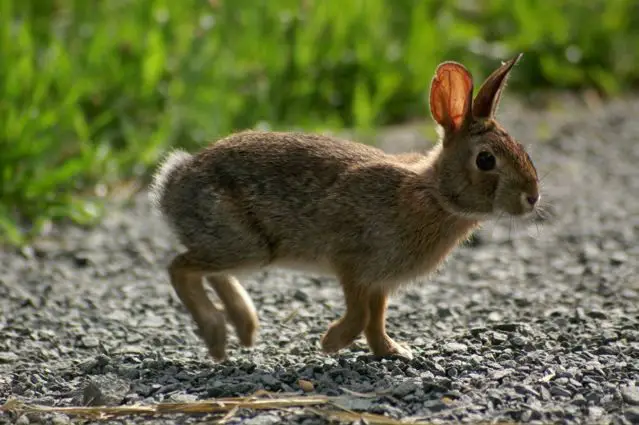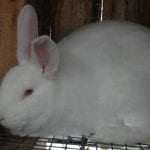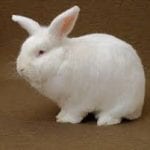Scientific Facts
| Common Name | Omilteme Cottontail |
| Scientific Name | Sylvilagus Insonus |
| Life Span | About 2 years |
| Size (Adult) | Medium-sized |
| Weight (Adult) | 3 kg |
| Body Shape | Large rabbit |
| Habitat | Summit of the Mountain Range |
| Country of Origin | The state of Guerrero, Mexico in the mountain of Sierra Madre del Sur |
Physical Description

Such a large rabbit with its long ears, the Omilteme Cottontails is one-of-a-kind pet to have. It features an average size of hind feet and short tails. Its ears are dark, black, and brownish in colors. While it features a black tip and black border, too. It comes in a distinct color of greyish-black with the mixing of black and red hairs found at the back. It also has its white bellies as more of its distinguishing feature.
About the exact estimate of the ears, it falls exactly between 53 and 63.5 millimeters. Its dorsal body is a mixture of black and rufous on the back with white color on the ventral surfaces. It has its tail that measures between thirty and forty-five millimeters. It has its hind feet having black soles and white tops.
Look through the Omilteme Cottontail’s large skulls with a broad braincase, long palate, large mandibular and maxillary tooth, incisive foramina, a short diastema, and shallow skull depth. Its dental formula consists of the 2/1 incisors, 0/0 canines, 3/2 premolars, 3/3 molars, totaling 28.
Fast Facts
Here are some of the fast facts about the Omilteme Cottontail:
Best Suited For: In the Wild Forests
Temperament: The Least Understood Rabbit as It Manifests Wild Behavior
Comparable Breeds: Not Indicated
Colors

This Omilteme Cottontail features a distinct coat coloration. Such as it features a dull grey as its coat and a dark and brown-black in the convex surface of the ear. It also features a red and brown color on the dorsal side combined with black. The sides are also then grey and black with white on the dorsal side. Its soles are also dark brown with reddish-black and white in the ventral side.
Lifestyle and Behavior
Very little is known about the lifestyle of the Omilteme Cottontail. This is because it is now one of the most endangered rabbits around the world. It is a nocturnal type of rabbit that can go active at dawn and dusk as well. But so far, most of the cottontails are solitary and asocial. They would come together only when it comes time for the breeding season. That also is true when there be a rare aggregation at the feeding site.
Habitat
The Omilteme Cottontail comes only in limited distribution. This rabbit can be found only in the Sierra Madre del Sur located in the state of Guerrero in Mexico. This also occurs sympatrically along with the Eastern cottontails and the Mexican cottontails.
As for the kind of habitat they need, it is restricted to humid and heavily-wooded forests. They need a dense undergrowth while creating burrows under other debris and rocks. They also are restricted to pine-oak and pine forests.
The Omilteme Cottontail can be found in the terrestrial and temperate types of habitat. That is when they live mostly in the mountains and the forests.
That only means to say that there is no need to make use of cages, indoor cages, and hutches. They will feel more secure only when they stay in the forests and mountains as their comfort zone.
Social Habits
Similar to other species of cottontails, the Omilteme Cottontail is a social creature. It is just that it prefers living in large groups. It could also be found with other multiple animals hunting for food together. They also frequently share burrow systems or burrows. They are more likely to feed in a group that keeps them safer from predators.
This breed of rabbit does not go on frequent interaction with humans. The social interaction would often end poorly for the rabbit. This is one contributing factor to the low population number of the Omilteme Cottontail. Human hunting, habitat destruction, and many more negatively impact the rabbit.
While many of the rabbit species have a healthy population, the Omilteme Cottontail has not been simply studied enough for people to know if its population is healthy or not. It is sadly believed to be a critically endangered species. It so far is known to belonging to many of the endangered rabbit species.
Eating Habits
The Omilteme cottontail is a herbivore type of rabbit. It also eats clumped grasses that are the same foods to the Mexican cottontails. These clumped grasses include the Muhlenbergia macroura, Stipa ichu, and Festuca amplissima. It also prefers eating on the vegetation of cortices of shrubs, grass shoots, young leaves of Forbes, and cultivated plants (maize, barley, and oats).
However, this breed of rabbit prefers eating slightly different foods. They also like to engage in the coprophagy. All other rabbits that include the Omilteme Cottontail eat plant species in twenty different flavor species. Other food sources include flowers, twigs, berries, leaves, stems, grasses, bark, and many more.
Bark from the small shrub stems, and young trees are eaten when the food supplies are scarce. And the winter months in the colder regions, these Omilteme cottontail feeds on the twigs and bark of woody vegetation.
Grooming
Only a little detail is highlighted for its grooming. It utilizes the glands on the groin, chin, and cheeks. It rubs the pheromones on the fur during the grooming session. It also deposits scent marks on the shrubs or rocks. It also uses feces or urine to leave the scent markings. Such odors can best advertise their mark territories or reproductive status.
Temperament and Personality
There is little known about the temperament and personality of the Omilteme Cottontail. However, it is known for its superb hearing, visual, and olfactory systems. It also emits distress calls as it squeals during the copulation, and it grunts when there appears an intruder.
Often known for its escapist personality, it tends to stay in the vicinity of the hiding places in the mountain ranges or territories. They escape predation by going into the holes and burrows. It loves to travel considerable distances and mountain ranges. It is natural for it to escape predators as it runs away.
This rabbit thumps its hind feet while it shows distress calls. The purpose of this is to warm the predators. The large and lateral set eyes of rabbits provide a circular field of vision. This allows them to avoid predators and detect motion.
It also communicates largely through a sense of smell while detecting odors. This is one feat of its personality that sets it remarkably.
Lifespan and Health Concerns
The lifespan of the Omilteme Cottontail has not ever been documented. It is safe to assume that its lifespan is the same as other closely related species of eastern cottontails and Mexican cottontails. That means to say that they have a short-lived life.
There is somehow a general relationship between its longevity and body size. The larger Omilteme Cottontail lives longer than the smaller one.
This breed of rabbit is bigger than the eastern cottontails. Their lifespan surpasses the average age of the eastern cottontails. This is somehow equivalent to three years.
Keep in mind as well that the Omilteme cottontail is smaller than the bigger Mexican cottontails. It can live up to five years. But most of the cottontail species do not live after reaching their fifth year in the forest or the wild.
Breeding
The video URL link presented above is concerned more about the breeding and reproduction of rabbits. But so far, no reports yet have been presented about the Omilteme cottontail reproduction.
The cottontails are known for the construction of nests, specifically underground. This is lined with the vegetation while they nurse their young and shed fur until finally reaching dependency at about two weeks old. The young cottontails are born in the altricial state.
The mating systems are as well not known, although they are believed to be the same as other cottontail species. This is where females and males meet with several mates.
The cottontail species breed seasonally during the warm months of the year. They also breed several times during the season with a gestation length of twenty-eight to thirty days. The female Omilteme Cottontail built nests after they are lined with vegetation.
Predation
Humans are the only predator recorded for the Omilteme cottontails. Other predators include the jaguars, pumas, coyotes, gray wolves, and zone-tailed hawks. They are frequently seen in the region of the Sierra Madre del Sur. But the good thing is that they are cryptic in color, enabling them to flee quickly for short distance.
Conservation Status
The Omilteme cottontail is an extremely rare known breed of rabbit. This is because of their restricted range in Guerrero, Sierra Madre del Sur, and Mexico. This is also due to their fragmented habitat in the mentioned ranges.
Dating back in 1990, they already were considered as an extinct specie. They also fell as endangered specie in 1994 and engaged specie in 1996.
The IUCN listed them under the red list category of endangered species. The Mexican Official norm also enlisted them to be critically endangered. This is due to the recovery of their skin in the year of 1998. The finding of the skin led in the survey of the rabbit for approximately fifty-two days. This resulted in no sightings of the Omilteme cottontail.
Other significant sources highlight the Omilteme Cottontail to be extinct. Its habitat deforestation is one factor causing its possible extinction or endangerment. The Sierra Madre del Sur was logged that caused the wide-scale fragmentation of the habitat.
Even poaching is believed to be a present concern. The natural reserve area of the Omiltemi State Ecological Park covers the cottontail habitat of the Omilteme Cottontail. Illegal hunting of the cottontail is still a major concern.
Cost
No specific cost has ever been mentioned about the purchase of the Omilteme Cottontail. This is due to the reason that it is not intended for domestication. This is a wild rabbit that thrives in the mountain ranges and the forests.
FAQs
How do the Omilteme Cottontail communicate with each other?
There is little known about the communication of Omilteme Cottontails. They also are more likely to have good senses of smell, vision, and hearing. They also occasionally use mating calls and distress calls.
What does the Omilteme Cottontail eat?
The Omilteme cottontail feeds on the bark, wood, stems, leaves, and flowers. And since it is not kept as a captive animal as it can be found in the forest and the mountain, there is no need to worry about the food to give to them.
What is the role the Omilteme Cottontail have in the ecosystem?
The Omilteme Cottontail has an impact on the habitat because of the plants that they eat. The forests and the mountain ranges are where many predators can be found. That is when they serve as a food source for them.
Do this cottontail breed cause problems?
No. They are not known for any sort of negative impact on humans.
How this cottontail breed interact with humans?
This cottontail breed is hunted by humans for a food source and a fur. That is why they resist humans the moment they see them.
Are the Omilteme Cottontail endangered?
Omilteme cottontail is an extremely endangered species that their extinction started in 1991.
What differs the Omilteme Cottontail from other members of Sylvilagus?
This breed is different from other members of Sylvilagus, as this has a bigger skull and wider zygomatic bone. This also has its wider carotid foramina, deeper rostrum, and dorsal extensions of the premaxillaries extending the posterior and the nasal. What more, it has a narrower post-dental and narrower basioccipital.
How does cottontail differ from the Mexican cottontail?
The Omilteme Cottontail is smaller in size from the Mexican cottontail. It is small in its length of the upper incisors, nasal length, skull length, auditory bulla length, the width of basioccipital, and depth of shield bullae, skull depth, and width across the infraorbital canals.

